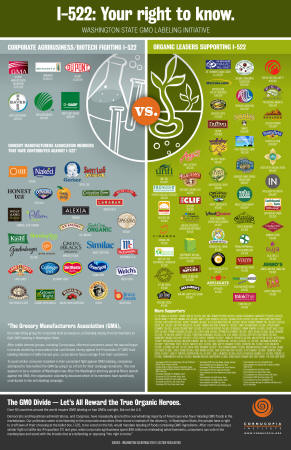|
Genetic Engineering (GE) of our food supply amounts to a massive science experiment being performed on mankind, without consent or full disclosure.
Although the biotech industry continues to claim GE products are safe, the truth is that no one knows what the long-term effects will be, because no one has done the necessary studies.
The loudest proponents of GE are the ones who stand to profit the most, and they don’t seem terribly concerned about the human or environmental costs.
What do we know for certain?
You may not realize that this reckless genetic experimentation is not limited to your food supply.
Besides being used to create drugs and “Frankenfish,” they’ve also created vaccine-containing bananas, goats that produce spider silk in their milk, venomous cabbage, chemotherapy chicken eggs, and even glow-in-the-dark cats.1
As creepy as some of these things are, the application that may have the greatest potential for global disaster are GE trees created to serve the desires of the paper industry.
Deforestation is already an enormous problem, and the last thing we need is to further stress our precious native forests and the flora and fauna that depend on them.
The documentary featured above discusses how GE trees may adversely impact ecological systems on a grand scale, with potentially catastrophic effects:
A Silent Forest - The Growing Threat, Genetically Engineered Trees hosted by Dr. David Suzuki 2
'The Greatest Threat to Native Forests Since the Chain Saw'
As Dr. Suzuki explains, the problem with genetic engineering has to do with the fact that GE plants and animals are created using horizontal gene transfer (also called horizontal inheritance), as contrasted with vertical gene transfer, which is the mechanism in natural reproduction.
Vertical gene transfer, or vertical inheritance, is the transmission of genes from the parent generation to offspring via sexual or asexual reproduction, i.e., breeding a male and female from one species.
By contrast, horizontal gene transfer involves injecting a gene from one species into a completely different species, which yields unexpected and often unpredictable results. Proponents of GE assume they can apply the principles of vertical inheritance to horizontal inheritance, and according to Dr. Suzuki, this assumption is flawed in just about every possible way and is “just lousy science.”
Genes don’t function in a vacuum - they act in the context of the entire genome. Whole sets of genes are turned on and off in order to arrive at a particular organism, and the entire orchestration is an activated genome.
It’s a dangerous mistake to assume a gene’s traits are expressed properly, regardless of where they’re inserted. The safety of GE is only a hypothesis, and in science, initial hypotheses typically end up being wrong.
GE foods are promoted as if they’ve been found to be safe, which is the farthest thing from the truth.
Why this rush to apply this science before testing it? The simple answer is, those promoting it stand to profit enormously from it. The timber, pulp, bioenergy, and fruit industries are rushing ahead with GE trees, with only their paydays in mind.
As the film states:
Why Genetically Engineer Trees?
Trees as being genetically engineered to give them unnatural characteristics, such as the ability to kill insects, tolerate toxic herbicides, grow abnormally fast, or have altered wood composition.
The paper pulp industry has to remove lignin from wood pulp before it can be used to make paper, which is an expensive part of the process. So, the biotech industry is working to create trees with lower lignin content.
The problem is, lignin is what gives trees their structural integrity.
It’s what allows trees to stand strong in wind and other weather, and to withstand diseases and damage from insect and animal browsing. Low lignin trees are weaker and less able to withstand these environmental stresses.
Dead low-lignin trees also decompose faster, releasing carbon dioxide into the atmosphere more quickly, which contributes to climate change.
The best thing for trees is to not use them for paper. Paper doesn’t need to be made from wood pulp, because there are more Earth-friendly materials such as agricultural wastes, recycled material, hemp, tobacco and even banana leaves.
Fruit trees are being genetically engineered for disease resistance. However, contamination of wild and organic fruit trees by genetically altered DNA has already had devastating consequences on nearby groves.
For example, GE papaya plantations have contaminated much of the organic and wild papaya trees in Hawaii.3
Nearly 20,000 papaya seeds from the Big Island and Oahu revealed GMO contamination. Eighty percent of the seeds tested were from organic farms, and the remainder were from wild trees and backyard gardens.
Contamination with GE DNA has caused many organic Hawaiian papaya growers to lose their plantations and/or their organic certification. Hawaiian GE papayas have now begun developing black spot fungus, so they have to be heavily sprayed with toxic fungicides every 10 days.
This is so typical of what happens to GE plants - they are weaker and more susceptible to disease and end up needing massive amounts of chemicals, usually in the form of herbicides and pesticides - to remain viable.
This is particularly tragic because there ARE so many far superior alternatives. Later this year, I will be reviewing many of the newer high performance agriculture techniques that far surpass virtually ANY benefit of GMO technology. I am currently identifying the leading experts in the US in this area.
It is crucial to have an alternative to the increasingly pervasive GMO technology as the list of adverse health effects from these toxic chemicals is growing all the time.
For example, the herbicide glyphosate (the active agent in Roundup) has been linked to miscarriages, premature births, and non-Hodgkin’s lymphoma. The only winner in this scenario is the biotech industry because it manufactures both the GE seeds and the toxic chemicals required to grow them.
The biotech industry has created the problem, as well as the “solution” that makes them rich.
The Spread of Seed and Pollen Is Uncontrollable. Period.
Genetically engineered trees vastly differ from other annual GE crops like corn and soybeans because trees can live for decades and even centuries in the wild.
Once GE trees escape the confines of their plantation, they are extremely difficult to eradicate. For this reason, the risks, regulation and assessment needs of GE trees are even greater than those of agricultural GE products like corn and soy.
Disrupting forest ecosystems endangers the health of the entire planet. Native forests have been called the “lungs of the earth,” providing food and wildlife habitats everywhere. Forests absorb carbon dioxide and produce oxygen, filter water and release it back into the atmosphere.
Many tree species, such as pines and poplars, can spread their pollen and seeds over great distances. Pollen can blow hundreds or even thousands of miles, opening the door for native forests to be dusted with GE pollen.
The contaminating of native forests is both inevitable and irreversible, according to the Global Justice Ecology organization.4
Some tree varieties are widespread throughout the world, and some are able to interbreed with similar species. Some tree types are highly invasive, such as Eucalyptus, a “bully” that has spread out of control across California.
Once wild tree species are contaminated, GE trees could take over vast geographical areas, and there is no do-over! You can recall a bad drug, but you can’t recall a bad tree.
Industry’s Answer to Cross-Contamination: The Terminator Gene
The biotech industry realized tree contamination would be a problem, so they developed the “terminator gene.” This gene causes the plant to produce a toxin that’s supposed to prevent its seeds from being viable, thereby preventing cross-contamination. Like the Terminator’s promise “I’ll be back,” Mother Nature trumps human ingenuity when it comes to nature’s drive to reproduce. Even the originators of the terminator gene admit it’s impossible to ensure 100 percent sterility.
The problem is, even a small amount of slippage can spread sterility to our native forests.
Consider the scenario of a native forest sitting adjacent to a GE tree plantation. Once contaminated, 95 percent of the native forest trees may become sterile, meaning they would produce no nuts, no seeds, no fruit, and no flowers or pollen. This renders the forest uninhabitable to native wildlife and rapidly degrades the soil.
This phenomenon is already being seen around the 100 to 150 GE tree test plots5 in the southern part of the US.
Monsanto’s Love Child, ArborGen
GE tree plantations may threaten to destroy global ecosystems and local farmers’ livelihoods, but they promise to make the biotech industry rich.
Genetically engineered trees and other crops become the property of the company that patented the seeds from which they grew. Monsanto has stolen more than 15 million dollars from farmers whose crops were contaminated by no fault of their own.
Once a farmer’s crop is contaminated, they can be sued by Monsanto, which manufactures the majority of the world’s GE seed. Even if only one percent of the crop is contaminated, patent law dictates that Monsanto gains possession of 100 percent of the crop. If this patent law goes unchallenged, ALL of the world’s natural resources could end up owned exclusively by biotech industry magnates.
The majority of GE research and development on trees has come from a company called ArborGen, the industrial “love child” from a tryst between Monsanto, International Paper, Westvaco and Fletcher Forests.6
Although Monsanto dropped out of the partnership early on, ties between Monsanto and ArborGen remain.
Barbara Wells, who was ArborGen’s CEO and President from 2002 to 2012, spent 17 years with Monsanto and headed its RoundUp Ready Soy division in Brazil. Similar parallels exist with ArborGen’s new CEO, Andrew Baum, and its VP of Business and Product Development, David Nothmann - who also happens to serve on committees in the Department of Energy and USDA.
The government has doled out numerous grants - well over $1 billion - to bioenergy companies and scientists to further the development of new bioenergies, many of which center on GE. The USDA is doing everything it can to hasten the approval of GE technology and silence the opposition.
According to Global Justice Ecology:
Final Thoughts
GE tree plantations threaten to spoil native forests, displace local farmers, and destroy sustainable economies.
Self-sufficient communities will be forced to leave their lands and find livelihoods elsewhere. Pollen and seeds from GE trees are impossible to control, even with “terminator gene” technology, and find a way to cross-pollinate wild trees with grim ecological consequences.
Pollen from GE trees may also cause brand new allergies that we may or may not be able to successfully address. Despite the obvious dangers, the profit-driven biotech industry, with the full backing of the US government, is pushing GE trees forward with ever-increasing zeal.
That said, there are some things YOU can do to help preserve our precious native forests:
For more information about GE trees, visit Global Justice Ecology.
To sign the Petition to Prohibit GE Trees, or Donate to the Global Justice Ecology Project, visit globaljusticeecology.org/petition.php. And be sure to support GMO labeling campaigns.
The food companies on the left of this graphic spent tens of millions of dollars in the last two labeling campaigns - in California and Washington State - to prevent you from knowing what’s in your food. You can even the score by switching to the brands on the right; all of whom stood behind the I-522 Right to Know campaign.
References
|


